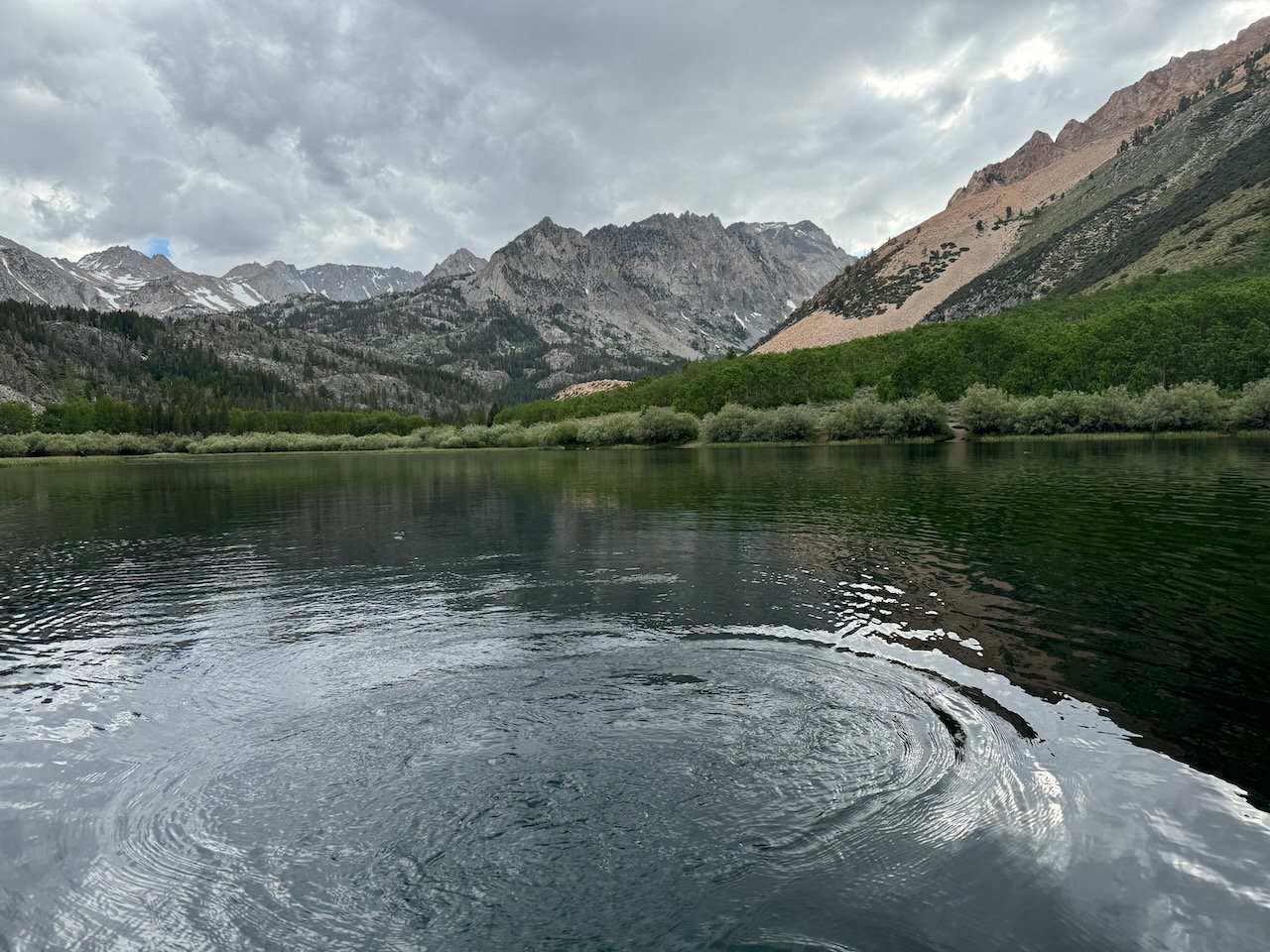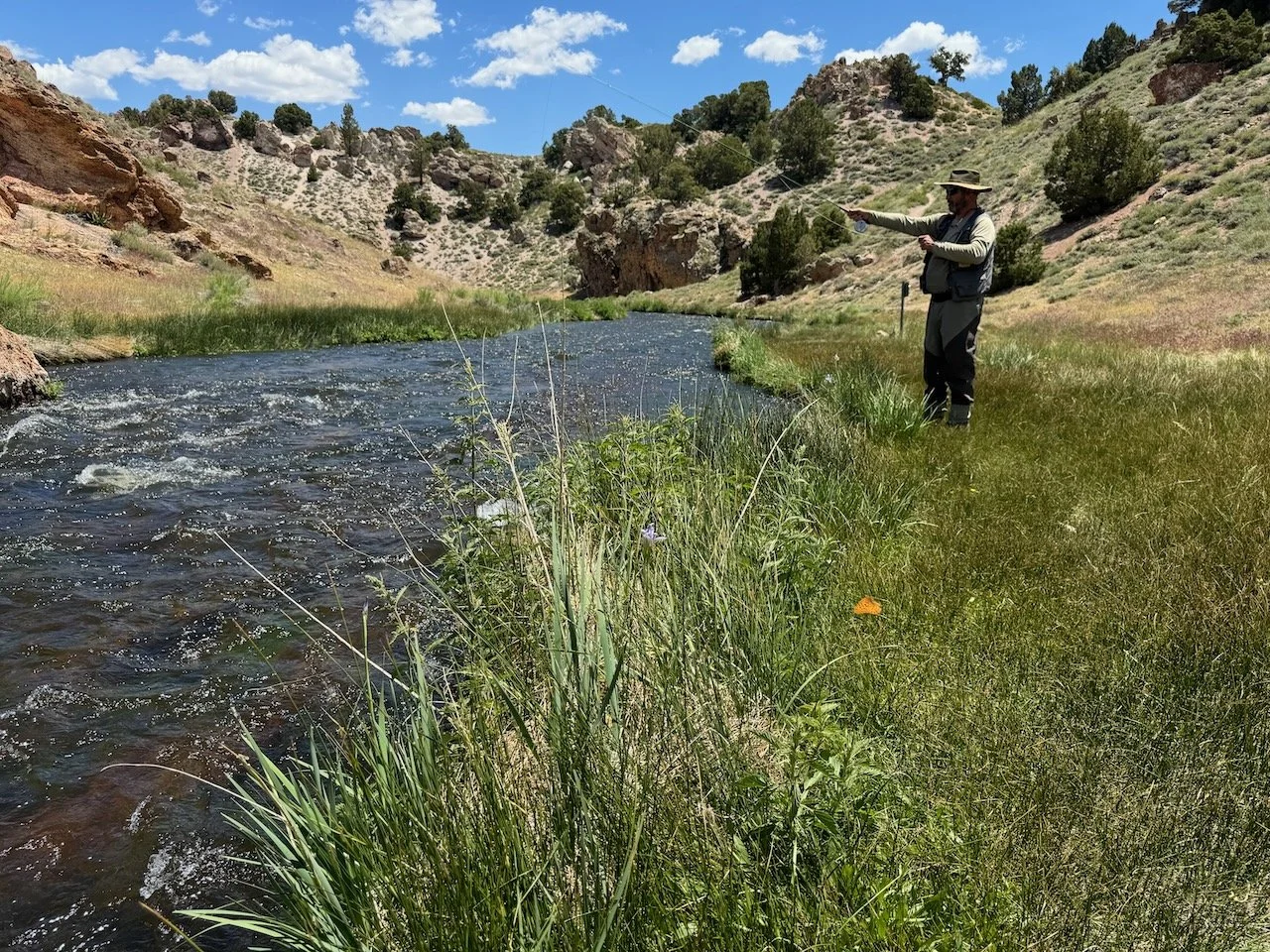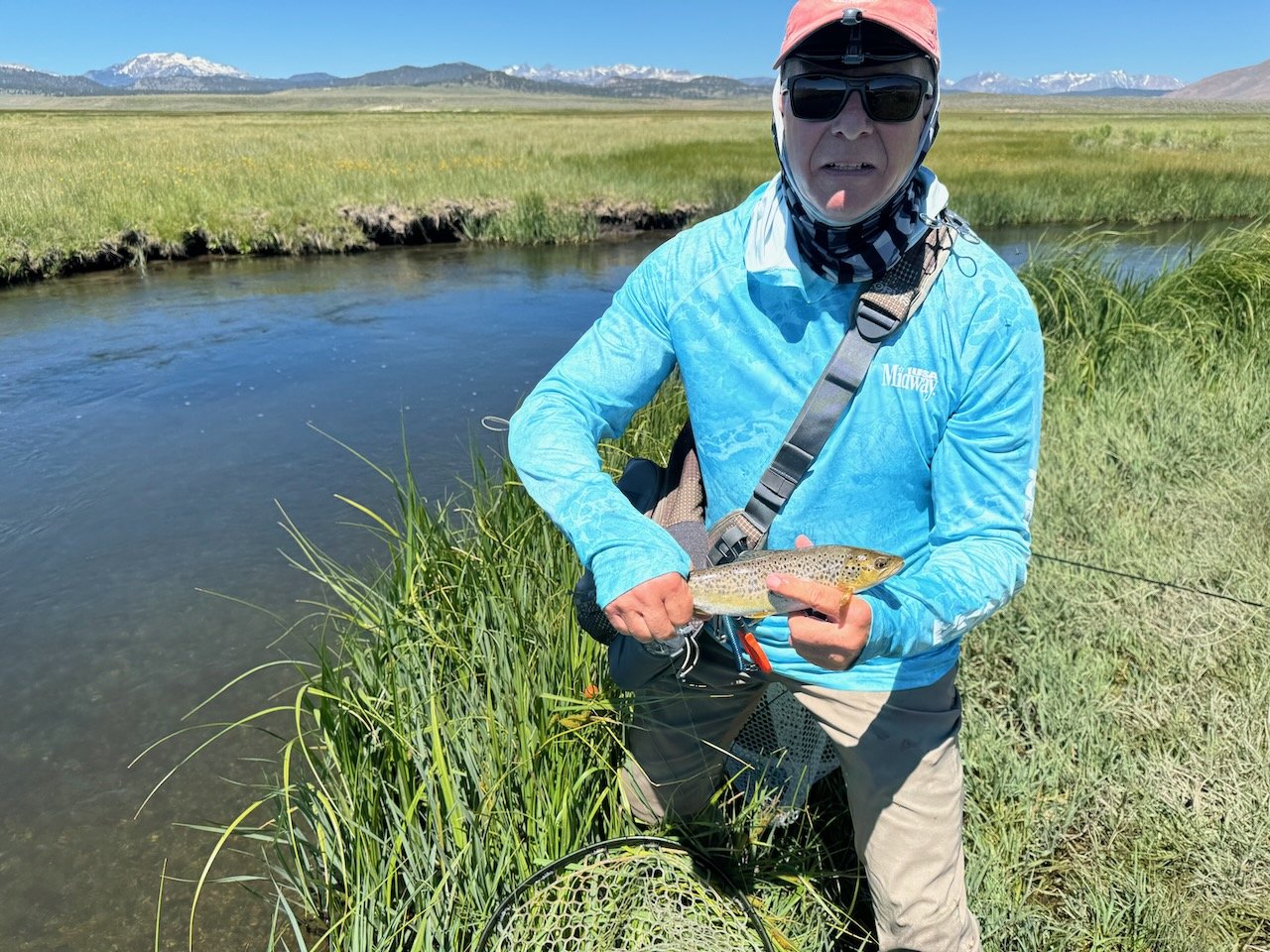Summer is here and the trout are feeding on adults, nymphs and emergers. Mosquitoes are out and about on the streams and lakes of the Eastern Sierra. Sunny days, windy days, overcast days, hot days and cool days have been what fly fishers are finding on any given day. Run off is on the downhill side and is most evident on the freestone creeks draining the eastern escarpment of the Sierra. Numerous waters are producing trout that are feeding on hatching mayflies, midges, and stoneflies. Now is the time to be out fly fishing the waters of the Eastern Sierra.
High altitude lakes like North Lake are offering fly fishers the opportunity to fly fish for wild rainbow, brown and brook trout.
Hot Creek
Interpretive Site:
Flows are decreasing as runoff is subsiding. Trout are feeding on the surface on blue wing olive mayflies and pale morning duns mayflies. When fishing tiny dry flies that are hard to see on the water fish with a dry and dry. Use a size 16 Adams parachute that the fly fisher can see and use as an indicator fly. Tie a three foot tippet of 5X or 6X monofilament to the bend of the Adams parachute and a size 20 blue wing olive parachute on the other end of the tippet. The big fly allows the fly fisher to see it on the water and then find the little fly. If you can’t find the little fly set the hook on any rise in a three foot circle around the Adams parachute. Size 16 pale morning dun parachutes, size 16 pale morning dun sparkle duns, size 20 blue wing olive parachutes and size 20 blue wing olive sparkle duns are the dry flies that are fooling the wild brown and rainbow trout of Hot Creek.
Nymphing under an indicator with a size one split shot, a size 18 bead head flash back pheasant tail nymph and an indicator is producing trout in the faster sections of Hot Creek Canyon..
Hot Creek
Canyon Section:
Nymphing with an indicator or a dry and dropper is producing trout in the canyon section as the water levels subside. In the faster sections of the canyon the increased weight need to drift the nymph on the bottom is too much for the dry fly to float. In these areas use an indicator three feet above the nymph. In the slower sections where you do not need additional weight us a dry fly like a stimulator or mini Chernobyl ant. Nymphing with a size 18 olive quilldigon, size 16 hot spot pheasant tail nymph, size 16 Frenchie, size 18 bead head flash back pheasant tail nymph, size 16 bead head flash back gold ribbed hare’s ear and size 16 Mercer’s poxy back pale morning dun is fooling the trout during the mid-morning to early afternoon hatch.
The north shore of McGee Bay is at full pool and the road around the lake is flooded in spots making it impossible to access with a vehicle.
Crowley Lake
North Landing:
The North Landing road continues to be closed. A tentative opening date is set for after the fourth of July. Hopefully it will be open on the 5th of July. There are section of the road that are still undriveable. For now there is shore access at Layton Springs, South Landing and Crooked Creek. Float tubers in the Hilton Bays are producing trout on midges fished three inches to four feet off the substrate. Browns, rainbows and cutthroats are taking tiger midges, zebra midges, blood midges, gray midges and albino Barron’s. The flotilla of boats have been concentrated in Hilton Bay and on the south side of McGee Bay.
Jimmy Steinmetz from Las Vegas took a beginners class from Sierra Bright Dot and was able to fool this wild brown trout on a fly.
Upper Owens River
Above Benton Crossing Bridge:
Flows on the upper Owens River have subsided and are at a great level to fly fish with nymphs and dries. Midges are hatching early morning followed by blue wing olive mayflies. After lunch time look for the pale morning duns to start hatching. Fly fishers need to move around to find concentrations of the hatching pale morning duns. Nymphing with an indicator or a Euro rig is producing five inch to 20 inch browns and rainbows. The trout are taking bead head flash back pheasant tail nymphs in size 18, bead head flash back gold ribbed hare’s ears in size 16, olive quilldigons in size 18, size 18 Frenchie’s, size 16 hot spot pheasant tail nymphs and size 12 stoner nymphs. Thoroughly covering the water with casts is the way to find the trout that are willing to take your fly. For dry flies fish with size 16 pale morning dun parachutes, size 18 blue wing olive parachutes and size 16 brown elk hair caddis. Particularly on the overcast days be sure to have bug repellant as the mosquitoes are thick.
Jamie Metzger from Woodland Hills used his inflatable kayak to ply the waters of North Lake with a dry and dropper rig to fool wild rainbow and brown trout.
Bishop Creek Canyon
North Lake:
Using motorless water craft like a float tube, kayak, inflatable kayak or Stealth Craft drift boats allows fly fishers total access to the lake. Fly fishers willing to walk into the inlet will find lots of fly fishing opportunities for wild brown and rainbow trout hanging out in the current waiting for food to drift to them. Working the vegetation lined banks with a dry and dropper is fooling trout. Use a size 14 Adams parachute on top and fish with a size 18 bead head flash back pheasant tail nymph on three feet of 5X fluorocarbon tippet. Other fly patterns that are working to fool the wild trout are size 14 olive stimulators, size 12 orange stimulators, size 14 elk hair caddis, tiger midges, zebra midges and blood midges in size 20 and bead head flash back gold ribbed hare’s ears in size 16. Trolling or striping a size 12 olive wooly bugger on a full sinking line is fooling the stocked rainbows. Bring the bug repellant as the mosquitoes are thick on the lake.
Early mornings and late evening are the best times to be on Bishop Creek Canal as the day time temperatures are too hot to be comfortable.
Bishop Creek Canal
Behind Bishop Veterinary Hospital:
If you can put up with the mosquitoes fishing the caddis ovipositing in the late evening is offering good fly fishing for eight to 12 inch wild brown trout. Fish with size 16 peacock elk hair caddis and olive elk hair caddis. Early in the morning fish with bead head flash back pheasant tail nymphs, olive quilldigons, stoner nymphs, copper John’s and hot spot pheasant tail nymphs.






